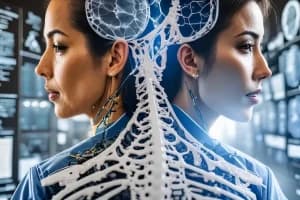Importance of Gemini AI Nutritionist
Nutritional guidance for As an expert in nutrition, the Gemini AI is a distinctive instrument that fits the needs of the person. Typical dietary recommendations sometimes take a one-size-fits-all approach, ignoring the multitude of variables that influence each person's particular nutritional needs. Alternatively, Gemini AI Nutritionist uses deep learning and advanced algorithms to assess a vast amount of data, including lifestyle characteristics, genetic information, eating patterns, and personal health profiles. It is capable of offering incredibly personalised advice that considers each individual's particular dietary restrictions, goals, and deficiencies. By improving the effectiveness of nutritional therapy, this customised approach raises user pleasure and engagement. The Gemini AI Nutritionist has the capacity to transform our understanding of nutrition and empower individuals to make choices that are optimal for their overall health and well-being.
Description of This Project
Gemini AI Nutritionist transforms dietary advice by utilising the potential of Gemini AI technology. This innovative concept creates a virtual dietitian that can provide individualised food recommendations by combining deep learning and sophisticated algorithms. Gemini AI Nutritionist gives customers the power to make educated decisions, optimise their nutrition, and reach their wellness objectives by examining their unique health profiles and preferences.
# Mount Google Drive
from google.colab import drive
drive.mount('/content/drive/')Setup
Install the Python SDK The google-generativeai package includes the Python SDK for the Gemini API. Use pip to install the dependency: The google-generativeai package includes the Python SDK for the Gemini API. Use pip to install the dependency:
Install the Python SDK
The google-generativeai package includes the Python SDK for the Gemini API. Use pip to install the dependency:
!pip install -q -U google-generativeai
Import packages
Import the necessary packages.
import pathlib import textwrap import google.generativeai as genai # Used to securely store your API keyfrom google.colab import userdata from IPython.display import displayfrom IPython.display import Markdown def to_markdown(text): text = text.replace('•', ' *') return Markdown(textwrap.indent(text, '> ', predicate=lambda _: True))
Setup your API key
You need to get an API key before you can access the Gemini API. Create a key in Google AI Studio with only one click if you don't already have one.
Get an API key
On Colab, click the "🔑" on the left panel and add the key to the secrets manager. Google API key should be given to it.
Once you have the API key, pass it to the SDK. You can do this in two ways:
- Put the key in the GOOGLE_API_KEY environment variable (the SDK will automatically pick it up from there).
- Pass the key to genai.configure(api_key=..........................)
GOOGLE_API_KEY=userdata.get('api_key')genai.configure(api_key=GOOGLE_API_KEY)
List models
It's now time for you to make a Gemini API request. List_models can be used to view the available Gemini models.
- For text-only prompts, Gemini-Pro is optimised.
- For text-and-image prompts, gemini-pro-vision is optimised.
for m in genai.list_models(): if 'generateContent' in m.supported_generation_methods: print(m.name) models/gemini-1.0-pro models/gemini-1.0-pro-001 models/gemini-1.0-pro-latest models/gemini-1.0-pro-vision-latest models/gemini-pro models/gemini-pro-vision
Generate text from text inputs
For text-only prompts, utilise the Gemini-Pro variant.
model = genai.GenerativeModel('gemini-pro')
%%timeresponse = model.generate_content("What are the essential macronutrients and micronutrients required for a balanced diet?") CPU times: user 51.4 ms, sys: 15.5 ms, total: 66.9 ms Wall time: 8.81 s to_markdown(response.text) Macronutrients
- Carbohydrates: Provide energy for the body and regulate blood sugar levels.
- Protein: Build and repair tissues, produce hormones and enzymes, and regulate fluid balance.
- Fats: Provide energy, aid in vitamin absorption, and support cell function.
Micronutrients
Minerals
- Calcium: Builds and maintains bones, regulates heart rate and muscle function.
- Magnesium: Relaxes muscles, supports heart health, and regulates blood sugar levels.
- Potassium: Regulates fluid balance, blood pressure, and nerve function.
- Sodium: Balances fluid levels and supports muscle function.
- Iron: Carries oxygen throughout the body and supports red blood cell production.
- Zinc: Supports immune function, wound healing, and cell growth.
- Iodine: Essential for thyroid hormone production.
Other Micronutrients
- Folate: Essential for DNA synthesis and red blood cell production.
- Vitamin B12: Supports nervous system function, red blood cell production, and DNA synthesis.
- Omega-3 fatty acids: Essential fats involved in brain function, heart health, and anti-inflammatory processes.
- Fiber: Non-digestible plant material that supports digestive health and regulates blood sugar levels.
%%timeresponse = model.generate_content("How does the body utilize carbohydrates, fats, and proteins for energy?") CPU times: user 68.6 ms, sys: 3.03 ms, total: 71.7 ms Wall time: 10.2 s to_markdown(response.text)
Carbohydrates:
- Ingestion and Digestion: Carbohydrates are ingested as starches or sugars. Enzymes in the mouth, stomach, and intestine break them down into glucose, which is absorbed into the bloodstream.
- Glucose Metabolism: Glucose enters cells and is metabolized through a series of biochemical reactions called glycolysis. This process produces energy in the form of ATP (adenosine triphosphate).
- Citric Acid Cycle (Krebs Cycle): Glucose is further metabolized in the mitochondria into molecules of acetyl-CoA. These enter the Krebs cycle, which generates energy-rich molecules like NADH and FADH2.
- Oxidative Phosphorylation: NADH and FADH2 are transferred to the electron transport chain, where electrons are passed along, releasing energy. ATP is produced as protons move across the inner mitochondrial membrane.
- ATP Utilization: The ATP produced from carbohydrate metabolism powers cellular processes such as muscle contraction, nerve signaling, and protein synthesis.
Fats:
-
- Ingestion and Digestion: Fats are ingested as triglycerides, which are molecules composed of glycerol and fatty acids. Enzymes in the stomach and intestine break down triglycerides into free fatty acids and glycerol.
- Free Fatty Acid Metabolism: Fatty acids are transported to the liver and other tissues. Inside cells, they undergo beta-oxidation, a series of reactions that break down fatty acids into acetyl-CoA.
- Citric Acid Cycle: Acetyl-CoA enters the Krebs cycle and is metabolized for energy production, similar to glucose.
- Oxidative Phosphorylation: Acetyl-CoA from fatty acids also contributes to the electron transport chain and ATP production.
- ATP Utilization: ATP from fat metabolism provides energy for cellular processes, particularly during prolonged exercise or when carbohydrate stores are depleted.
Proteins:
- Ingestion and Digestion: Proteins are ingested and broken down into amino acids by enzymes in the stomach and intestine.
- Amino Acid Metabolism: Amino acids are transported to cells where they can be utilized for protein synthesis or energy production.
- Deamination: The amino group of amino acids is removed in a process called deamination. The remaining carbon skeleton can be converted into acetyl-CoA or other molecules.
- Krebs Cycle and Electron Transport Chain: Acetyl-CoA and other molecules derived from amino acids enter the Krebs cycle and electron transport chain, contributing to energy production.
- ATP Utilization: ATP from protein metabolism can provide energy for cellular processes, although it is primarily used for protein synthesis and tissue repair.
%%timeresponse = model.generate_content("What are omega-3 fatty acids, and what are some good dietary sources of them?") CPU times: user 50.5 ms, sys: 11.1 ms, total: 61.5 ms Wall time: 7.83 s to_markdown(response.text)
Omega-3 Fatty Acids
Omega-3 fatty acids are essential fatty acids, meaning the body cannot produce them on its own and must obtain them from the diet. They play vital roles in various physiological processes.
Types of Omega-3 Fatty Acids
There are three main types of omega-3 fatty acids:
- Eicosapentaenoic acid (EPA)
- Docosahexaenoic acid (DHA)
- Alpha-linolenic acid (ALA)
Dietary Sources of Omega-3 Fatty Acids
- Fatty Fish: Salmon, mackerel, tuna, herring, sardines
- Shellfish: Mussels, oysters, clams
- Fish Oil Supplements: Derived from fatty fish or algae
- Flaxseeds: Rich in ALA, which can be converted to EPA and DHA in the body
- Chia Seeds: Another good source of ALA
- Walnuts: Contain small amounts of ALA and EPA
- Avocados: Contain some ALA
- Edamame: A good vegan source of ALA
Recommended Intake
The American Heart Association recommends consuming at least two servings of fatty fish per week. This provides approximately 250mg of EPA and DHA combined.
Health Benefits of Omega-3 Fatty Acids
Omega-3 fatty acids have been linked to numerous health benefits, including:
- Reduced risk of heart disease
- Improved brain function and memory
- Reduced inflammation
- Lowered blood pressure
- Improved mood and reduced anxiety
- Enhanced skin health
Considerations
While omega-3 fatty acids are generally considered safe, individuals with allergies or fish intolerances should be cautious. It's always advisable to consult with a healthcare professional before making significant dietary changes.
%%timeresponse = model.generate_content("How can individuals manage portion sizes to maintain a healthy weight and prevent overeating?") CPU times: user 67.9 ms, sys: 17.3 ms, total: 85.2 ms Wall time: 11.8 s
Generate text from image and text inputs
A multimodal model (gemini-pro-vision) that takes in inputs in the form of text and images is offered by Gemini. Text output is returned via the GenerativeModel.generate_content API, which is made to accommodate multimodal prompts.
Let's add this picture:
model = genai.GenerativeModel('gemini-pro-vision')
import PIL.Imageimg = PIL.Image.open('/content/drive/MyDrive/image1.png')img
response = model.generate_content(img) to_markdown(response.text)
A balanced meal consists of a protein, a vegetable, and a starch. This meal has chicken, vegetables, and cauliflower.
response = model.generate_content([""" You are an expert in nutritionist where you need to see the food items from the image and calculate the total calories, also provide the details of every food items with calories intake is below format 1. Item 1 - no of calories 2. Item 2 - no of calories ---- ---- Finally you can also mention whether the food is healthy or not and also mention the percentage split of the ratio of carbohydrates, fats, fibers, sugar and other important things required in our diet """, img], stream=True)response.resolve() to_markdown(response.text)
The image contains the following food items:
- Grilled chicken breast (2 pieces): 300 calories
- Brown rice (1/2 cup): 100 calories
- Steamed broccoli (1/2 cup): 50 calories
- Steamed carrots (1/2 cup): 50 calories
- Steamed cauliflower (1/2 cup): 25 calories
- Bell peppers (1/2 cup): 25 calories
- Olive oil (1 tablespoon): 120 calories
Total calories: 670 calories
The food is healthy because it is low in calories and contains a good balance of carbohydrates, fats, and proteins. The food is also high in fiber, which is important for good digestion.
The percentage split of the ratio of carbohydrates, fats, fibers, sugar and other important things required in our diet is as follows:
Carbohydrates: 45% Fats: 30% Proteins: 25% Fiber: 10% Sugar: 5%
response = model.generate_content(["How many total calories are in this image?", img], stream=True)response.resolve() to_markdown(response.text)
480 calories
response = model.generate_content(["Is the food in this image good for health?", img], stream=True)response.resolve() to_markdown(response.text)
Yes. The image shows a plate of grilled chicken breast and vegetables. This is a healthy meal because it contains a good balance of protein, carbohydrates, and vegetables. The chicken is a lean protein source, and the vegetables are a good source of vitamins, minerals, and fiber. The meal is also low in calories and fat.
img = PIL.Image.open('/content/drive/MyDrive/image2.png')img
response = model.generate_content(img) to_markdown(response.text)
A vegan diet is one that excludes all animal products, including meat, dairy, eggs, and honey. There are many reasons why people choose to adopt a vegan lifestyle, including ethical concerns about the treatment of animals, environmental concerns about the impact of animal agriculture on the planet, and health concerns about the consumption of animal products.
There is no one-size-fits-all vegan diet, as the best way to eat a vegan diet will vary depending on your individual needs and preferences. However, there are some general tips that can help you get started on a vegan diet.
- Make sure you're getting enough protein. Protein is essential for building and repairing tissues, and it can be found in a variety of plant-based foods, such as beans, lentils, nuts, seeds, and tofu.
- Eat plenty of fruits and vegetables. Fruits and vegetables are packed with vitamins, minerals, and fiber, and they can help you maintain a healthy weight.
- Choose whole grains over refined grains. Whole grains are a good source of fiber, which can help you feel full and satisfied.
- Limit your intake of processed foods. Processed foods are often high in unhealthy fats, sugar, and salt.
- Drink plenty of water. Water is essential for good health, and it can help you stay hydrated and feeling your best.
If you're new to a vegan diet, it's a good idea to talk to your doctor or a registered dietitian to make sure you're getting all the nutrients you need. There are also many resources available online to help you learn more about a vegan diet and how to make it work for you.
Here are some additional tips for making a vegan diet work for you:
- Start slowly. Don't try to make all of your meals vegan overnight. Start by making one or two vegan meals each week, and gradually increase the number of vegan meals you eat as you become more comfortable with the diet.
- Find vegan recipes that you enjoy. There are many delicious vegan recipes available online and in cookbooks. Experiment with different recipes until you find ones that you love.
- Make vegan meals social. Invite your friends and family to join you for vegan meals. This can be a great way to share your love of vegan food and to show others how easy and delicious it can be.
- Don't be afraid to ask for help. If you have any questions about a vegan diet, don't hesitate to ask your doctor, a registered dietitian, or a vegan friend or family member.
A vegan diet can be a healthy and satisfying way to eat. By following these tips, you can make a vegan diet work for you.
response = model.generate_content([""" You are an expert in nutritionist where you need to see the food items from the image and calculate the total calories, also provide the details of every food items with calories intake is below format
1. Item 1 - no of calories 2. Item 2 - no of calories ---- ---- Finally you can also mention whether the food is healthy or not and also mention the percentage split of the ratio of carbohydrates, fats, fibers, sugar and other important things required in our diet """, img], stream=True)
response.resolve()
to_markdown(response.text)
- Hummus - 166 calories
- Pita bread - 166 calories
- Carrots - 50 calories
- Peppers - 30 calories
- Celery - 6 calories
- Almonds - 163 calories
- Kale - 9 calories
- Red Cabbage - 22 calories
- Cauliflower - 25 calories
- Sandwich - 350 calories
- Salad - 20 calories
- Chickpeas - 269 calories
- Quinoa - 222 calories
- Asparagus - 20 calories
- Avocado - 160 calories
- Smoothie - 330 calories
Total Calories: 1810 calories
The food items in the image are healthy and provide a good balance of carbohydrates, fats, fibers, sugar, and other important things required in our diet. The percentage split of the ratio of these nutrients is as follows:
Carbohydrates: 45% Fats: 30% Fibers: 10% Sugar: 5% Other: 10%
response = model.generate_content(["Make a list of how many calories you should eat each day by age?", img], stream=True)response.resolve() to_markdown(response.text)
|
Age |
Calories per day |
|---|---|
|
2-3 years |
1,000-1,400 |
|
4-8 years |
1,200-1,600 |
|
9-13 years |
1,600-2,200 |
|
14-18 years |
2,000-2,800 |
|
19-50 years |
2,000-2,800 |
|
51-70 years |
1,800-2,400 |
|
71+ years |
1,600-2,200 |
These are just general guidelines. Your individual calorie needs may vary depending on your activity level, weight, and other factors. Talk to your doctor or a registered dietitian to determine how many calories you should eat each day.
response = model.generate_content(["Tell me what food to eat every day?", img], stream=True) response.resolve() to_markdown(response.text) A healthy balanced meal should include a variety of food that provides the nutrients the body needs to function properly. A typical daily meal plan might include:
- Breakfast: Oatmeal with fruit and nuts, or a smoothie made with yogurt, fruit, and vegetables.
- Lunch: A salad with grilled chicken or fish, or a sandwich on whole-wheat bread with lean protein and vegetables.
- Dinner: Salmon with roasted vegetables, or a stir-fry with chicken or tofu and vegetables.
- Snacks: Fruit, vegetables, yogurt, or nuts.
It is important to vary your meals and snacks throughout the day to ensure that you are getting a variety of nutrients. It is also important to drink plenty of water throughout the day.
Conclusion
An innovative initiative called the Gemini AI Nutritionist makes individualised nutrition advice by using deep learning and artificial intelligence. It provides customised advice to maximise nutrition and support improved health outcomes by evaluating genetic information, lifestyle variables, and individual health profiles. The technology possesses the ability to continuously learn and adapt, which could revolutionise personalised healthcare and enable people to make informed food choices for better overall health.







